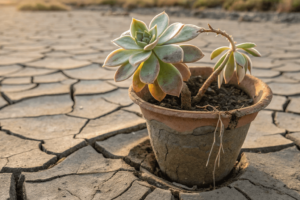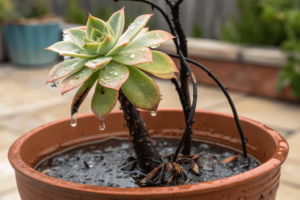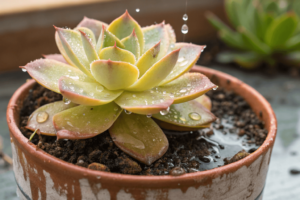I found myself desperately searching “why is my succulent dying?” the day I looked down at my once-glorious succulent and realized something was wrong.
There it was – my Instagram-worthy green companion, now a sad, drooping mess that looked like it had given up on life faster than I gave up on my New Year’s resolutions.
Sound familiar?
Let me guess: You have done everything “right.” You followed those cutesy plant care infographics, and you’ve watched countless YouTube tutorials.
Also Read: When Should I Water My Succulents? Simple Tips for Perfect Timing
You have probably even talked to your plant (no judgment – we have all been there). Yet somehow, your succulent is staging a dramatic exit, leaving you feeling like a total plant parent failure.
But here’s the plot twist: This is not the end of your succulent’s story.
I’ve been in the trenches of plant rescue more times than I can count, and the question “Why Is My Succulent Dying?” has led me to countless discoveries.
Time and again, what seemed like certain plant doom has transformed into a miraculous comeback.
Your succulent isn’t just dying – it’s communicating.
And I’m here to help you become fluent in “succulent.”
Buckle up, plant parent. We’re about to turn your wilting wonder into a thriving desert, darling.
No green thumb required – just a little knowledge, some tough love, and the kind of plant-saving swagger that would make even the most experienced botanist nod in respect.

Why Is My Succulent Dying
1. Watering Woes: The #1 Succulent Killer
Let’s discuss the most common plant parent mistake: overwatering. Succulents are desert dwellers—basically, the camels of the plant world. They store Water in their plump leaves and hate sitting in moisture.
Signs of Overwatering:
- Mushy, translucent leaves
- Yellowing or blackening at the base
- Soft, waterlogged stems
- Soil that never seems to dry out
2. Lighting: Not All Sunshine is Created Equal
Succulents are sun lovers, but they’re not sunbathing champions. Too much direct sunlight can be just as deadly as too little.
Sunburn Warning Signs:
- Brown or black scorched patches
- Leaves turning white or pale
- Crispy, dried-out appearance
Optimal Light Conditions:
- Bright, indirect sunlight
- 4-6 hours of gentle morning or afternoon sun
- Rotate your plant weekly for even exposure
3. Soil and Drainage: The Foundation of Succulent Health
Your succulent’s soil is its lifeline. Standard potting soil is a death trap, like forcing a fish to live on land.
Ideal Soil Mix:
- 2 parts coarse sand
- 1 part perlite
- 1 part potting soil
- Ensure pots have drainage holes
4. Temperature and Humidity: Comfort Zones Matter
Succulents are drama queens when it comes to environmental changes.
Temperature Sweet Spot:
- 60-80°F (15-27°C)
- Protect from extreme cold or heat
- Avoid drafty windows and heating vents
How to Save an Over-Watered Succulent with a Black Stem

Succulents with blackened stems are in critical condition, but they can often be saved with swift and precise action. Follow this detailed guide to rescue your plant:
Step 1: Assess the Damage
Carefully inspect your succulent for:
- Black, mushy areas on the stem indicate rot.
- Foul odours emanate from the stem or roots.
- Roots that are slimy, black, or brown, as these are no longer healthy.
Further steps will be necessary if the rot extends beyond the stem into the roots.
Step 2: Remove Damaged Parts
Using clean, sterilized scissors or pruning shears:
- Trim off all visibly rotted portions, ensuring you cut into healthy, firm tissue.
- Dispose of the infected pieces immediately to prevent the spread of fungal or bacterial infections.
Step 3: Let It Dry Out
Once the damaged areas are removed:
- Allow the plant to air dry for 2–3 days in a shaded, well-ventilated space.
- Ensure the cut ends are entirely sealed and calloused before replanting.
Step 4: Repot in Fresh Soil
Repotting is crucial to prevent further damage:
- Use a fresh succulent or cactus potting mix with excellent drainage.
- Place the succulent in a clean pot with drainage holes to allow excess Water to escape.
Step 5: Water Sparingly
- After repotting, wait 5–7 days before watering to give the plant time to recover.
- Water only when the soil is fully dry, and use the “soak and dry” method to avoid overwatering.
Step 6: Monitor Recovery
- Place the succulent in a bright but indirect light location to reduce stress.
- Watch for new growth or firmer leaves as signs of recovery.
- If no improvement occurs, consider propagating healthy cuttings as a last resort.
How Do I Know If Succulent Is Overwatered?

Overwatering is the leading cause of succulent distress. Catching the signs early can prevent severe damage.
Key Symptoms of Overwatering
Discolored Leaves:
- Yellowing or translucent leaves often indicate too much Water.
Mushy Texture:
- Leaves that feel soft or soggy signal water retention in the plant’s cells.
Falling Leaves:
- Overwatered leaves may detach with the slightest touch.
Edema:
- Look for small, blister-like bumps on leaves caused by internal water pressure.
Persistently Wet Soil:
- If the soil remains damp for days after watering, it could suffocate the roots.
Preventive Tips
- Stick to a Watering Schedule: Let the soil dry completely between waterings.
- Choose Well-Draining Soil: Use specialized mixes that promote aeration and drainage.
- Opt for Pots with Drainage: Avoid decorative pots without holes.
- Tailor Care to Conditions: Adjust watering based on seasonal humidity and temperature changes.
By recognizing these symptoms and adjusting, you can ensure your succulent thrives.
Can You Revive a Dying Succulent?

Absolutely! Even a struggling succulent can return if you act quickly and provide the care it needs.
Encouragement
Succulents are naturally resilient. Their ability to store Water in their tissues gives them a remarkable survival advantage, even when faced with neglect or improper care.
Actionable Steps to Revive
Identify the Problem:
- Is the plant overwatered, under-watered, infested with pests, or receiving the wrong light?
Take Corrective Action:
- Overwatering: Remove rotted parts and repot in fresh soil.
- Underwatering: Slowly reintroduce Water.
- Improper light: Move to an optimal lighting environment.
- Pests: Treat with natural remedies or safe insecticides.
Be Patient:
- Growth takes time. Focus on providing a stable, low-stress environment for your succulent to recover.
Prevention Tips
- Research the care requirements of your specific succulent variety.
- Use tools like moisture meters to prevent overwatering.
- Regularly inspect your plant for signs of stress or pest infestations.
With diligence and care, your succulent can thrive once again!
How Do I Save My Succulent From Dying?
The first step to saving your succulent is playing plant detective. Succulents thrive on specific care, and pinpointing the issue is key.
Here’s a quick guide:
1. Repot in Fresh Soil Succulents need well-draining soil that prevents Water from sitting around their roots.
The ideal soil mix should include:
- Coarse sand
- Perlite or pumice
- Minimal organic matter
- Cactus or specialized succulent potting mix
Repotting steps:
- Carefully remove the plant from its current pot
- Gently shake off old soil from the roots
- Trim away any black, mushy, or dead roots
- Let the plant dry for a day or two to callus any cut areas
- Place in a new pot with drainage holes
- Fill with fresh, well-draining succulent soil
- Wait a week before watering to allow any root damage to heal
2. Cut Back on Watering Overwatering is the most common cause of succulent decline.
Signs of overwatering include:
- Soft, mushy leaves that look translucent and feel waterlogged
- Yellowing or browning leaves that drop off easily
- Black or dark brown spots indicating root rot
- Leaves that feel soggy and lose their firm, plump appearance
Most succulents prefer a “soak and dry” method.
Water thoroughly but infrequently, letting the soil completely dry out between waterings.
Reduce watering even further during dormant seasons (winter for most species).
A good rule of thumb is to water only when the soil is completely dry and at least 1-2 inches deep.
3. Reduce Light Some succulent varieties are sensitive to intense direct sunlight:
- Look for signs of Sunburn: white, brown, or scorched patches on leaves
- Move sensitive varieties away from harsh afternoon sun
- Use sheer curtains to filter intense light
- Provide afternoon shade for delicate species
- Gradually acclimate plants to prevent shock
4. Water Deeply Effective watering for succulents means:
- Thoroughly saturate the soil until Water runs out of drainage holes
- Allowing complete drainage
- Waiting until the soil is arid before the next watering
- Using room temperature water
- Avoiding getting Water on the leaves to prevent rot
5. Increase Light Most succulents love bright, indirect light. To gradually increase light exposure:
- Start by placing the plant in a bright area with filtered light
- Slowly move closer to a window over several weeks
- Watch for signs of sunburn (white or brown patches)
- Rotate the plant regularly for even growth
- Aim for 6-8 hours of bright, indirect sunlight daily
6. Treat for Pests Common succulent pests include:
- Mealybugs: White, cottony masses on leaves and stems
- Spider mites: Tiny web-like structures, yellowing leaves
- Scale insects: Small, hard bumps on stems and leaves
Treatment methods:
- Isolate infected plants
- Remove pests manually with alcohol-dipped cotton swabs
- Use neem oil or insecticidal soap
- Ensure good air circulation
- Avoid overwatering, which can attract pests
Additional Tips:
- Different succulent species have unique care requirements
- Always research the specific needs of your particular succulent variety
- Be patient – recovery can take weeks or months
- Prevent future issues by maintaining a proper care routine
What Is the Trick to Keeping Succulents Alive?
Ah, the age-old question. Keeping succulents alive boils down to mastering these essentials:
1. The Right Light
Succulents are sun lovers, but not all thrive in direct, blazing sunlight.
- Indoor succulents: Place them near a south- or east-facing window.
- Outdoor succulents: Protect them from harsh midday rays.
2. The Right Soil
Regular potting soil is a no-go for these divas. They need fast-draining soil. You can buy a cactus mix or DIY one with sand, perlite, and potting soil.
3. Proper Watering Schedule
Remember: Less is more. Stick to the “soak and dry” method, letting the soil dry completely between waterings.
Will Succulents Regrow After Dying?
Good news! Many succulents are resilient and can bounce back from neglect or near death.
What to Do:
- Check the roots: Your plant has a fighting chance if they‘re healthy.
- Propagate: If parts of the plant are unsalvageable, use healthy leaves or stems to grow new plants.
Why Is My Indoor Succulent Dying?
Indoor succulents face unique challenges, often linked to light, humidity, or watering.
Common Issues:
Insufficient Light: Your succulent might crave sunlight, leading to leggy growth or pale leaves.
- Solution: Move it closer to a sunny window or consider a grow light.
Overwatering
- Indoor plants dry out slower than outdoor ones. Overwatering is a top culprit.
- Solution: Stick to a sparse watering schedule and ensure your pot has drainage.
High Humidity: Succulents prefer dry air. High humidity can stress bathrooms or kitchens out.
- Solution: Place them in well-ventilated areas.
Why Are Succulents So Hard to Keep Alive?
Succulents have a reputation for being easy-care, but they are surprisingly fussy if their basic needs aren’t met.
Their main Achilles’ heel? Over-loving plant parents.
Why They Struggle:
- A mismatch between care routines and their natural desert environment.
- Misconceptions about their low-maintenance label.
What Does a Dying Succulent Look Like?
Spotting early signs of trouble can mean the difference between life and death for your plant. Here’s what to watch for:
Symptom Cause Solution
Yellow, mushy leaves Overwatering Let the soil dry out; check for root rot.
Wrinkled, dry leaves Underwatering Water deeply, but don’t drown it.
Brown, crispy edges Sunburn Move to indirect light.
Leggy, stretched-out growth Insufficient light Relocate to a brighter spot or use grow lights.
Conclusion
Succulents may seem high-maintenance in disguise, but once you crack the code, they’re the perfect plant companions. Monitor their environment and water sparingly, and give them plenty of sunlight to thrive.
Do you have a succulent SOS story or tips of your own? Share them in the comments below—I would love to hear from you!
You can grab yours succulents on Amazon.
Disclaimer: Always monitor your plant’s unique needs and adjust care accordingly.








